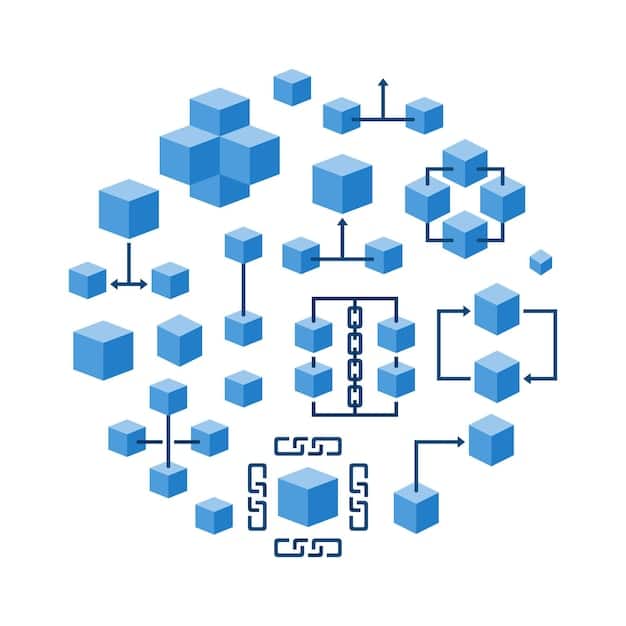Cloud-Native Application Development: A Guide for US Software Teams

Cloud-native application development empowers US software teams to build scalable, resilient, and rapidly deployable applications by leveraging technologies like containers, Kubernetes, and microservices for enhanced business agility and competitive advantage.
Is your US-based software team ready to embrace the future of application development? Cloud-native application development offers a transformative approach to building and deploying software in the cloud era.
Understanding Cloud-Native Application Development
Cloud-native application development is more than just moving your applications to the cloud. It’s a paradigm shift that requires a new way of thinking about software architecture, development processes, and deployment strategies. It’s about building applications that are designed to thrive in dynamic, scalable, and resilient cloud environments.
This approach leverages technologies like microservices, containers, Kubernetes, DevOps, and CI/CD pipelines to deliver exceptional user experiences while accelerating development cycles and reducing costs. Let’s dive deeper into the core principles and components of cloud-native application development.
The Core Principles
At the heart of cloud-native development lie several key principles that guide the design and implementation of applications. These principles ensure that applications are well-suited for the cloud environment and can take full advantage of its capabilities.
- Microservices: Breaking down applications into smaller, independent services that can be developed, deployed, and scaled independently.
- Containers: Packaging applications and their dependencies into lightweight, portable containers for consistent execution across different environments.
- DevOps: Fostering collaboration between development and operations teams to automate and streamline the software delivery lifecycle.
- CI/CD: Implementing continuous integration and continuous delivery pipelines for rapid and reliable software releases.
By embracing these principles, US software teams can create applications that are not only more scalable and resilient but also easier to manage and update.
In essence, understanding these core tenets paves the way for harnessing the full potential of cloud-native architectures, leading to more agile, efficient, and competitive software development practices.
Benefits of Cloud-Native for US Software Teams

Adopting a cloud-native approach offers numerous advantages for US software teams, impacting everything from development speed to operational efficiency. These benefits can translate into a significant competitive edge in today’s rapidly evolving market.
Let’s examine some of the most compelling reasons why your team should consider transitioning to cloud-native development.
Increased Agility and Speed
Cloud-native architectures enable faster development cycles and more frequent releases, allowing teams to respond quickly to changing business needs and customer demands.
- Faster Time to Market: Microservices and CI/CD pipelines accelerate the delivery of new features and updates.
- Improved Collaboration: DevOps practices foster better communication and collaboration between development and operations teams.
- Enhanced Responsiveness: Cloud-native applications can be quickly adapted to changing market conditions and user feedback.
With increased responsiveness and agility, US software teams can stay ahead of the curve and deliver innovative solutions faster than ever before.
This enhanced agility provides US teams with the capability to rapidly iterate, test new features, and address user feedback, fostering a culture of continuous improvement and innovation.
Key Technologies in Cloud-Native Development
Cloud-native application development relies on a set of powerful technologies that work together to enable the creation of scalable, resilient, and agile applications. Understanding these technologies is crucial for US software teams looking to embark on their cloud-native journey.
These technologies often form the backbone of any successful cloud-native implementation, providing the necessary tools and frameworks to build, deploy, and manage applications effectively.
Containers and Kubernetes
Containers, such as Docker, provide a standardized way to package applications and their dependencies, ensuring consistent execution across different environments. Kubernetes, a container orchestration platform, automates the deployment, scaling, and management of containerized applications.

Together, containers and Kubernetes enable US software teams to build highly scalable and resilient applications that can adapt to changing workloads.
These technologies provide the foundation for managing complex application deployments and ensuring high availability, which is essential for modern software solutions.
Service Meshes
Service meshes, such as Istio, provide a layer of infrastructure that handles communication between microservices, providing features like traffic management, security, and observability.
- Traffic Management: Route traffic between different versions of microservices for A/B testing and canary deployments.
- Security: Secure communication between microservices with mutual TLS authentication.
- Observability: Gain insights into the performance and behavior of microservices with metrics, logging, and tracing.
US software teams can leverage service meshes to simplify the management of complex microservices architectures and improve the reliability and security of their applications.
By employing service meshes, teams can focus on developing business logic without being bogged down by the complexities of inter-service communication, leading to more efficient and reliable applications.
Best Practices for US Teams Adopting Cloud-Native
Transitioning to cloud-native development requires more than just adopting new technologies. It also involves embracing new ways of working and following best practices to ensure success. For US software teams, this means aligning with industry standards and tailoring practices to their specific needs.
Let’s explore some of the key best practices that can help US teams make a smooth and effective transition to cloud-native development.
Embrace Automation
Automation is crucial for streamlining the software delivery lifecycle and reducing the risk of errors. US software teams should automate everything from building and testing to deployment and monitoring.
This includes automating infrastructure provisioning, application deployments, and security checks. Automation not only increases efficiency but also improves the reliability and consistency of the software delivery process.
With automation, US teams can free up valuable time and resources, allowing them to focus on innovation and delivering exceptional user experiences.
Focus on Observability
Observability is the ability to understand the internal state of a system by examining its outputs. US software teams should invest in tools and practices that provide comprehensive observability into their cloud-native applications.
- Metrics: Track key performance indicators (KPIs) to monitor the health and performance of applications.
- Logging: Collect and analyze logs to identify and troubleshoot issues.
- Tracing: Trace requests as they flow through different microservices to understand dependencies and identify bottlenecks.
By focusing on observability, US teams can quickly detect and resolve issues, ensuring the reliability and availability of their applications. Furthermore, robust observability enables proactive problem-solving, preventing minor issues from escalating into major incidents.
Challenges and Considerations for US Teams
While cloud-native application development offers numerous benefits, it also presents several challenges and considerations for US software teams. Understanding these challenges is crucial for planning and executing a successful cloud-native transformation.
Addressing these challenges proactively can help US teams avoid common pitfalls and maximize the value of their cloud-native investments.
Complexity
Cloud-native architectures can be complex, especially when dealing with microservices and distributed systems. US software teams need to invest in training and tools to manage this complexity effectively.
This includes tools for monitoring, tracing, and debugging distributed applications, as well as expertise in container orchestration and service mesh technologies.
In addition to technical complexity, US teams may also face organizational complexity, requiring them to adopt new ways of working and collaborating to ensure success.
Security
Securing cloud-native applications requires a different approach than traditional applications. US software teams need to implement robust security measures at all stages of the software delivery lifecycle.
- Container Security: Scan containers for vulnerabilities and enforce security policies.
- Network Security: Secure communication between microservices with mutual TLS authentication.
- Access Control: Implement strict access control policies to limit access to sensitive data and resources.
By prioritizing security, US teams can protect their applications and data from threats and ensure compliance with industry regulations.
This holistic approach ensures that security is not an afterthought but an integral part of the entire development process.
Getting Started with Cloud-Native in the US
Embarking on a cloud-native journey can seem daunting, but with the right approach, US software teams can successfully adopt cloud-native practices and technologies. Starting with a clear understanding of the team’s goals and a well-defined strategy is essential.
Let’s explore some practical steps that US teams can take to get started with cloud-native development.
Start Small
Don’t try to migrate all your applications to cloud-native at once. Start with a small, non-critical application to gain experience and build confidence.
This allows you to experiment with different technologies and approaches without risking disruption to your core business operations. As you gain experience, you can gradually migrate more complex applications to the cloud-native platform.
By starting small, US teams can learn from their experiences and refine their approach before scaling up their cloud-native initiatives.
Invest in Training
Cloud-native development requires a different skillset than traditional application development. US software teams should invest in training and education to ensure that their developers, operations engineers, and security professionals have the necessary skills.
This includes training on containers, Kubernetes, DevOps, CI/CD, and other cloud-native technologies. By investing in training, US teams can build a strong foundation for their cloud-native initiatives and ensure long-term success.
This investment in skills will also enable the team to adapt to new technologies and methodologies as the cloud-native landscape continues to evolve.
| Key Aspect | Brief Description |
|---|---|
| 🚀 Microservices | Independent services for scalable development. |
| 📦 Containers | Portable packages for consistent execution. |
| ⚙️ DevOps | Collaboration for streamlined delivery. |
| 🛡️ Security | Implement robust measures at all lifecycle stages. |
Frequently Asked Questions (FAQ)
Cloud-native application development is an approach to building and running applications that fully leverages the advantages of the cloud computing model by using technologies like containers, microservices, and DevOps.
Key benefits include increased agility, faster time to market, improved scalability, enhanced resilience, and reduced costs, enabling US teams to innovate and compete more effectively.
Essential technologies include containers (Docker), container orchestration (Kubernetes), service meshes (Istio), CI/CD pipelines, and DevOps tools for automation and collaboration.
Start with a small project, invest in training, embrace automation, focus on observability, and gradually migrate more complex applications to build expertise and confidence.
Main challenges include complexity, security concerns, cultural shifts, and the need for specialized skills and tools to manage distributed systems effectively and securely.
Conclusion
Cloud-native application development represents a significant opportunity for US software teams to modernize their applications and accelerate their digital transformation journey. By embracing cloud-native principles, technologies, and best practices, US teams can build applications that are more scalable, resilient, and agile, enabling them to innovate faster and compete more effectively in the cloud era.





